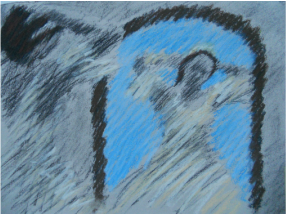
7. Start your paintings or pastel drawings with a tonal underlayer. When working with chalk pastels dark colours can be hard to achieve. Degas solved this by drawing in charcoal first, with strong dark contrasts. he then sealed this layer with fixative and applied colour on top. The same approach can be taken with oil paint - a dark tonal layer can help clarify the drawing and strengthen the use of colour in subsequent layers.
8. Scrape down your first blocking in of an oil painting. By pressing the paint into the weave of the canvas the colours are softened and smudged. This allows the painting to be redefined in a more selective way. You can reconsider what to strengthen and what to give extra emphasis to.
9. Explore ways of applying oil paint in a lively and textured way, e.g with fingers, a roller, a palette knife. Experimenting with a variety of pastel marks such as hatching, scribbling, dotting and dashing helped Degas to find new ways of creating different textures in oil paint.
10. Try combining several figures into one composition, particularly dynamic ones. If you experiment with different arrangements you will discover how they influence each other to produce a sense of movement through the picture.
A FEW SPACES ARE AVAILABLE ON THE PASTEL WORKSHOP SATURDAY 28TH MARCH - see website for details.
 RSS Feed
RSS Feed